Hesperus the Pack-Cow
Updated 9 November 2023
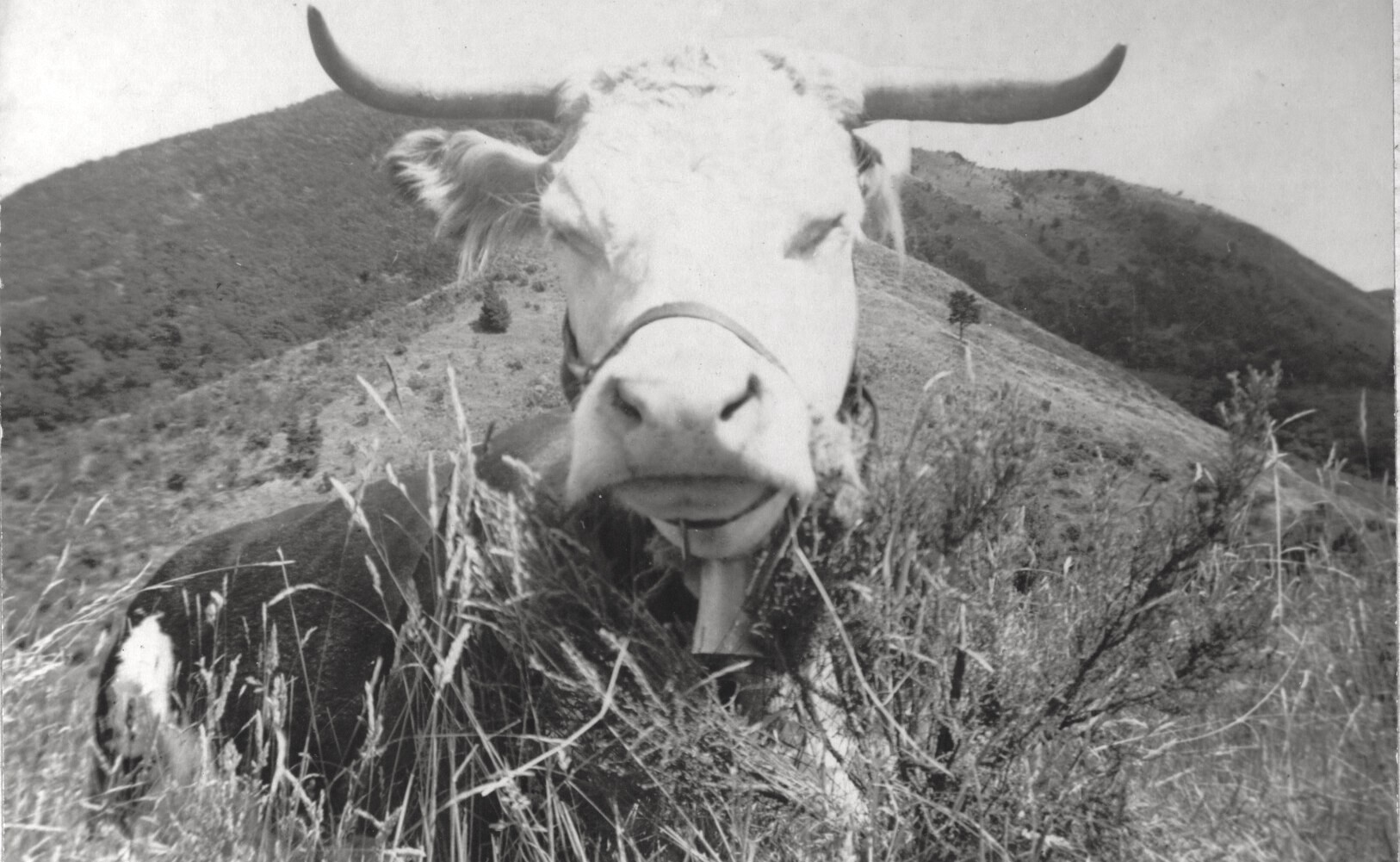
Introduction
My Uncle Charlie worked on a farm at Clarence River near Kaikoura in the South Island of New Zealand and, before that, near Balfour in Southland. I never met him but in the 1950s he sent me some photo enlargements of his activities around the Seaward Kaikoura Mountains near the Clarence river. This document is a start at finding out more about Charlie and to assist my sister Diane and cousin Jenny who are both interested in Charlie's activities. Uncle Charlie's farm was the same one where three cows were stranded on a small patch of elevated grass created after destruction of the Kaikoura earthquake.
My sister Diane was researching Uncle Charlie and she subsequently discovered Jane Millton's book about the same farm. I hunted out some photos and notes and I have written what I know here. Jane Millton wrote Moo and Moo and the Little Calf too. This is a children's book about the two cows and a calf stranded by the earthquake. During a trip to the South Island, with my wife Désirée, we met Jane and Derrick Millton on their farm. One of the storage rooms in their house is named Charlie's room which he occasionally used.
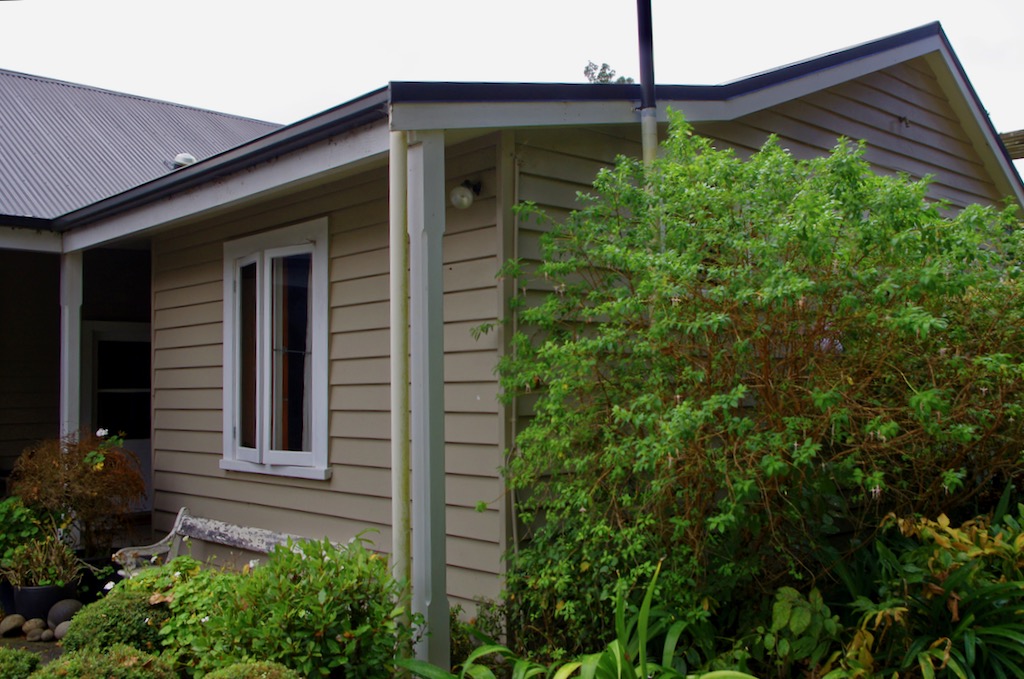
Jane knew Charlie when she was a child. She has since written a second children's book Moo and Moo and Can You Guess Who?.

South of the Clarence river or Waiau Toa is known as Waipapa Bay and Clarence Bridge is the settlement located just north of the river. A nice post-earthquake description of the area is in New Zealand Geographic. Charlie is mentioned briefly.
For part of his annual leave Charlie took trips into the Seaward Kaikouras, which bordered the farm. The weight of a small tent and provisions for several days was heavy to carry. Charlie enlisted the help of Hesperus, a horned Hereford cow, to carry what he needed. Some fresh milk was usually available from Hesperus for breakfast and tea. He used a small bottle of rennet to allow him to make cheese from the remaining milk.
Charlie had a good stock of Weetbix as it was light and fresh and preparation was easy, especially with some fresh milk and sugar. In addition, Hesperus would have carried some farm eggs, bacon, biscuits, fruit, butter and spreads.
Hesperus was just as sure-footed as a pack-horse in the difficult terrain. The grazing available may have suited Hesperus better. Charlie was on holiday, so there was no hurry.
The trip distance was about 10 kilometres and the final elevation was around 1000 metres. At the western end of the farm there are three river branches. The middle Miller Stream branch is widely gravelled making for slow but steady travel, with some grazing along the way and a few options if the weather deteriorates. The following link shows the Miller Stream Topographic map. This stream originates from the mountain slopes just north-east of Tarahaka, also shown in a photo below. At the upper end of this branch are some spectacular alpine landscapes featuring in the photos below. Charlie left Hesperus to graze in peace while he did a few day trips up the steep slopes.
Hesperus means the western evening star, namely Venus. This name is derived from the Greek hesperos and the Latin word vesper meaning, roughly, the western evening. Hesperides is from Greek "daughters of the west" the nymphs who tended the garden with the golden apples.
Hesperus

On the back of this photo Charlie has written:
"Laden with full packs that great cow Hesperus makes her own way steadily forward over the stony rubble which is washed down from the mountains when the snows thaw in their season. My tent is slung over the top of the other dunnage which consists of my tea, bed and breakfast, so to speak.
I would ask the reader to observe the rather glum expression on the face of Hesperus as compared to the photo above the introduction. As I well know myself (in pre-Hesperus days) a weeks' tea, bed and breakfast really CAN be heavy when carried on one's back."
Hesperus has one wide body strap behind the front legs. This is attached to a leather cover that acts as a simple saddle for attaching the loads. The side loads in sacks are simply hung over the cover using ropes. A long wooden stick, with some plant material caught on the forward end, lies along the top of the rolled-up tent and is tied on. This was, most likely, picked up from the river bed downstream. The stick could be used as a convenient ridge-pole on the tent to reinforce it. A ridge-pole lies along the top of the tent, often inside, but here it may be outside and showing as a dark line in the photo below. The photo shows no typical sag along the top of the tent.
I have changed the above paragraph several times as it is still a bit of a puzzle, but I am trying to develop the simplest explanation based on what I see in the photos. For example, I can see the edge of the cover under the loads, in the photo above. It is quite thick, so it is likely to be leather. Also, there are several straight sticks at the left of the photo.
Canvas fabric was the material of choice for packing things in and for making tents. It tended to hold water out, by surface tension, as long as the surface was not disturbed. We were always told not to touch the inside surface of the tent if it was raining. We used to have a canvas bag, which was used to carry fresh water from a water source to the camp-site.
On arrival at a suitable camp site it was too dull for Charlie to take any photos.
"Being an historical event in New Zealand history's progress, in the present era of mechanical transport, it may come as a surprise to many to know that only recently (Dec 1947) a heavy swag was transported a distance of approximately 6 miles, and to an altitude of some 2 to 3 thousand feet through very rough mountainous country, by a cow. The camper consumed the milk produced by the above animal. Owing to dull weather this photo was taken next day, following arrival. Thus the packs are not on her back. (the plants in the photo are Maori Onion)"
In the photo below Hesperus is grazing at the camp site. Charlie's tent is in the background and some clothing is drying on a line. His boots may be draped over the tent, one each side. The weather can be severe in this area so Charlie has chosen a nice sheltered camp site with some grazing for Hesperus. This black and white photo, in summer, looks towards the south. This photo and the description by Charlie was provided by my sister Diane.
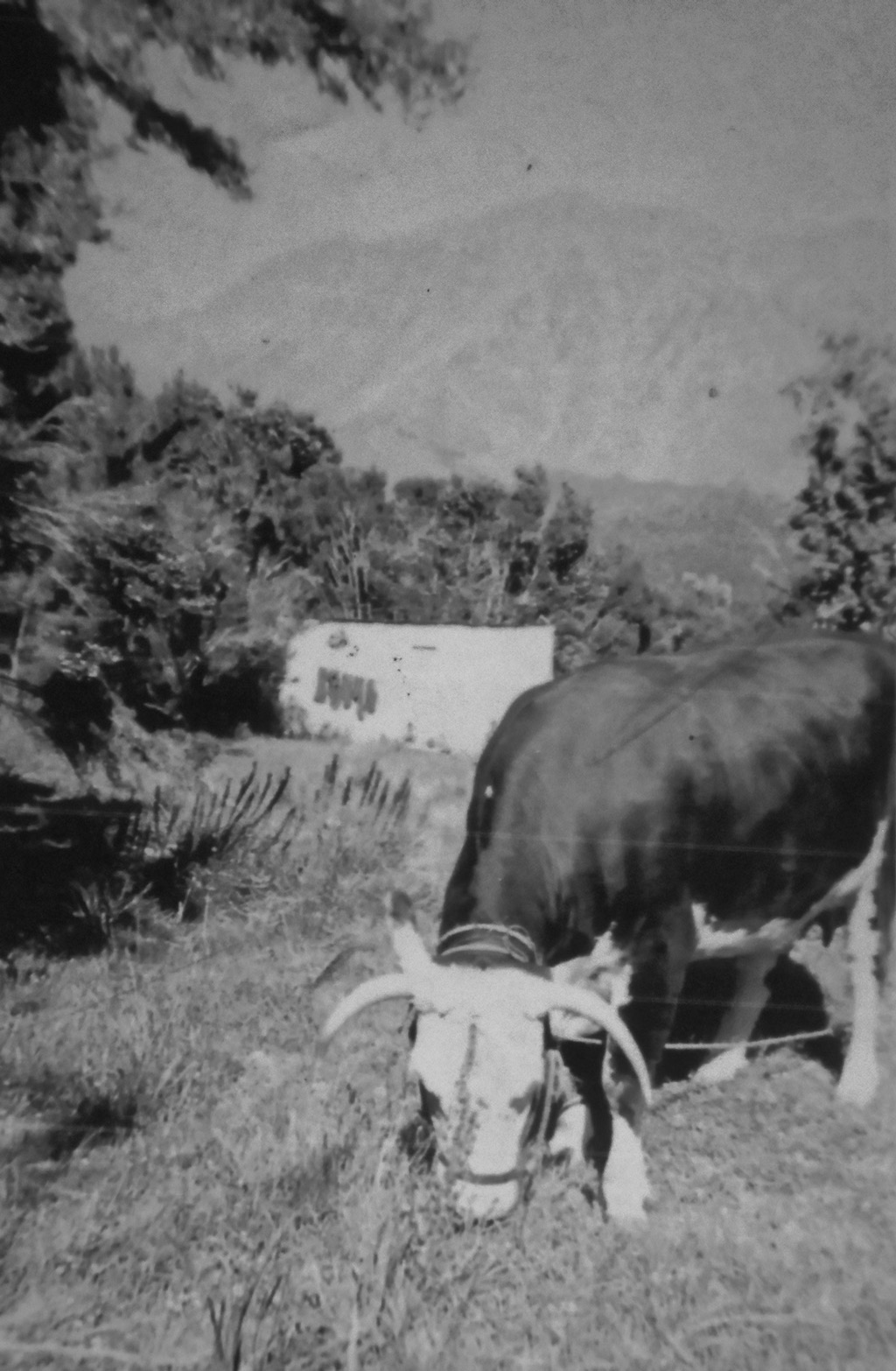
The following photo shows possibly the same tent pitched near the Hollyford Valley road. The brothers Neil, Charlie and Ian were on a bike ride to the Homer Tunnel construction site in the late 1930s. Strong wind is distorting the tent, in spite of the paired guy ropes at each end. The ridge pole, mentioned above, would have helped here.

I placed a photo of Hesperus at the top of this web page, because I like it, but it really belongs here.
On the back of the serene picture at top Charlie has written:
"This is next day. My tent is pitched down in the Valley below. We have climbed some distance up the mountain side. A nice patch of grass has been found. Why go any further. There we both are. I, stretched out full length on the tussock and Hesperus sound asleep (after a feed). Aloft the bell birds are singing. So are the cicadas. Our heavy burdens of yesterday forgotten. Life is very pleasant lying there watching the clouds sail by.
I nearly forgot about the cow-bell. Because Hesperus can smell where I have gone she therefore thinks that I can smell where she has gone. She forgets that many generations of civilisation has caused me to lose much of the sense of smell my ancestors once had. So if she wanders off (and I can't smell where she has gone) then it does not matter much, for the cow bell sends out its pleasant chime to tell me her whereabouts."
Climbing further up, and leaving Hesperus to graze below, Charlie took a photo of Mount Alexander, referred to at the time as the feminine Mount Alexandra. This round looking mountain is actually the northern end of a long limestone ridge. This photo and the description by Charlie was provided by my sister Diane.
"Mt. Alexandra, 4,000 ft, belongs to Mr. Shand National M.P. for Marlborough. Photo taken by me. This photo was taken from just above the Glen Hut and shows the magnificent views that one sees from the Glen Hut. The white on the mountain is not snow; but pure limestone. There are also wonderful limestone caves on this mountain."

I have used the photos above to create a single story. They were probably taken at different times. The fictional aspect is relatively small.
Charlie's Playground
Below are some other photos of the surroundings where Charlie explored. He made these trips during his annual leave.

The caption written on the back of this photo is:
"This is the beautiful Coral Shrub which is only to be found in Marlborough. As its name indicates it resembles coral.
The ridges on the left are composed of extremely dark coloured rock in contrast to the lighter coloured rock of the mountain slope in the foreground. There are patches of blue coloured rock as well.
In the running shingle a great variety of interesting plants are to be found. One such plant, in order to adjust itself to the unusual surroundings, has adopted a form which resembles a cushion while others again may grow leaves and stems of a rubber-like form and upon which the rain of falling shingle from above has little effect. Up here it is the survival of the fittest!
NOTE: I will send you 2 further enlargements when they come."
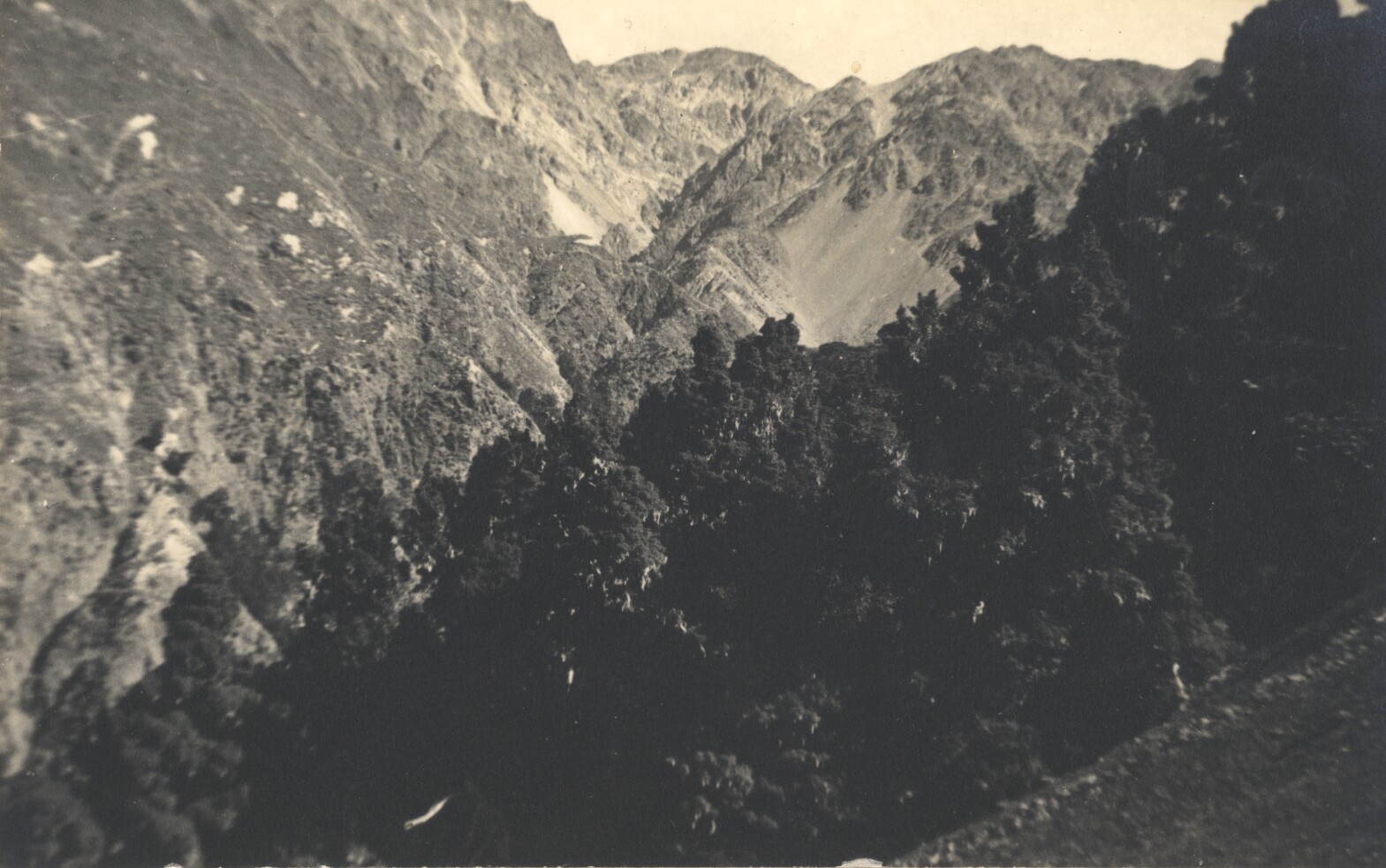
"This picture was taken some 4,000 feet up in the Seaward Kaikouras. I think it is mostly owing to the heavy snow, which these high levels are subject to, which is the cause of such an intense deep green in the foliage of everything which grows at this height. The Alpine Totara (Hall's Totara), in this instance, is of such an intense deep green as to appear almost black in colour. Owing to the fact that these levels extend up into the Mist Belt also causes extensive growths of the Bearded Lichen to flourish; several "beards" of which can be observed dangling from the branches, giving the forest a weird appearance. The trees themselves have a peculiar bunched appearance. The mountain in the centre is Tarahaka between 7,000 and 8,000 feet in altitude."

This balanced rock has now probably fallen to the valley floor in the recent earthquake, or an earlier one. Large balanced rocks are not uncommon. They protect the ground underneath from weathering and they also compress loose ground locally, making it slightly stronger as a structure than the surroundings. To the right of the rock a valley has formed which contains a trail of loose rocks making their way to the valley floor. Eventually the balanced rock will be left sitting on top of an isolated, slightly reinforced and sheltered rock pillar.
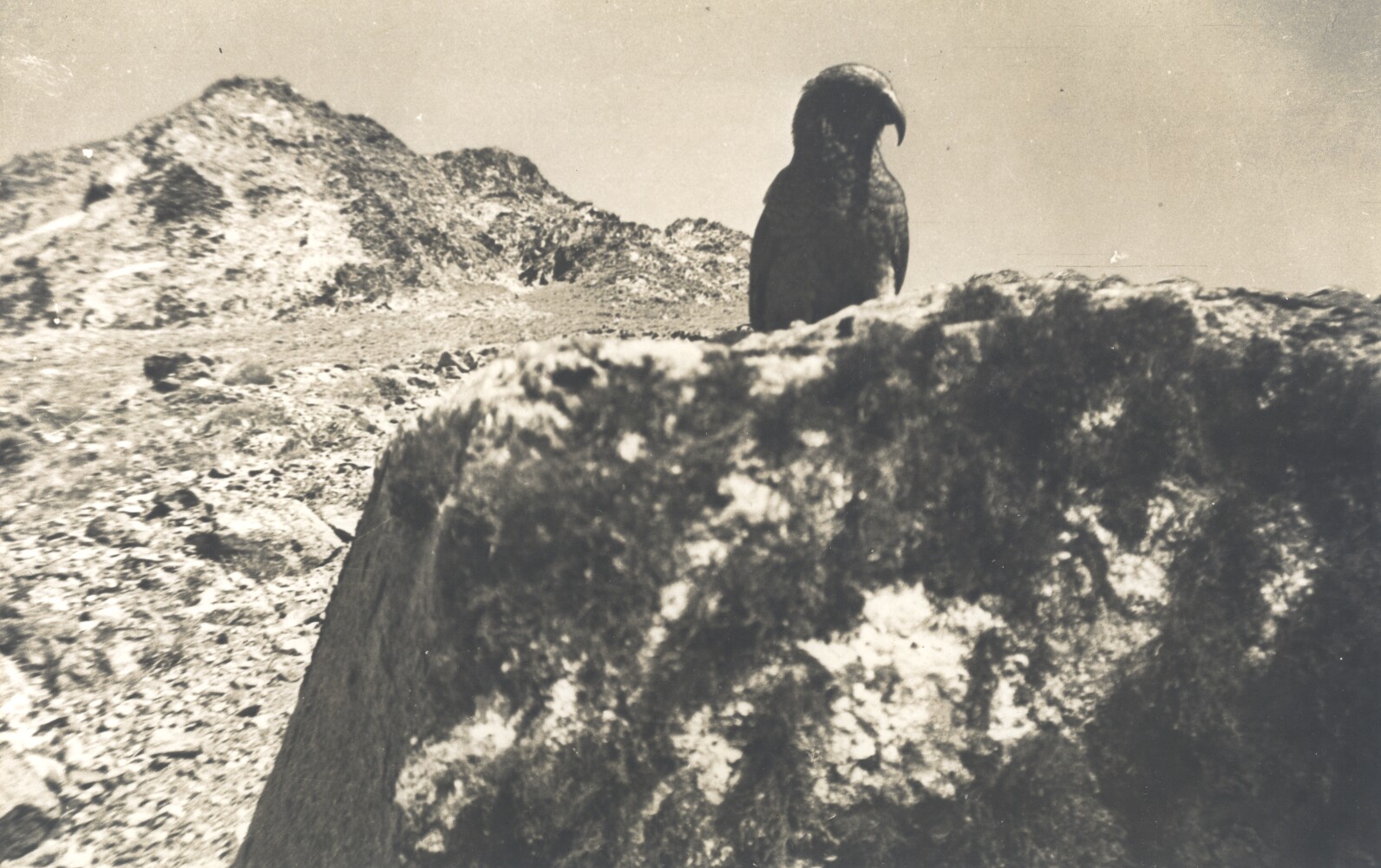
The Native Kea is New Zealand's alpine Parrot. It is a large, strong and very curious olive-green parrot with scarlet patches under the wings.
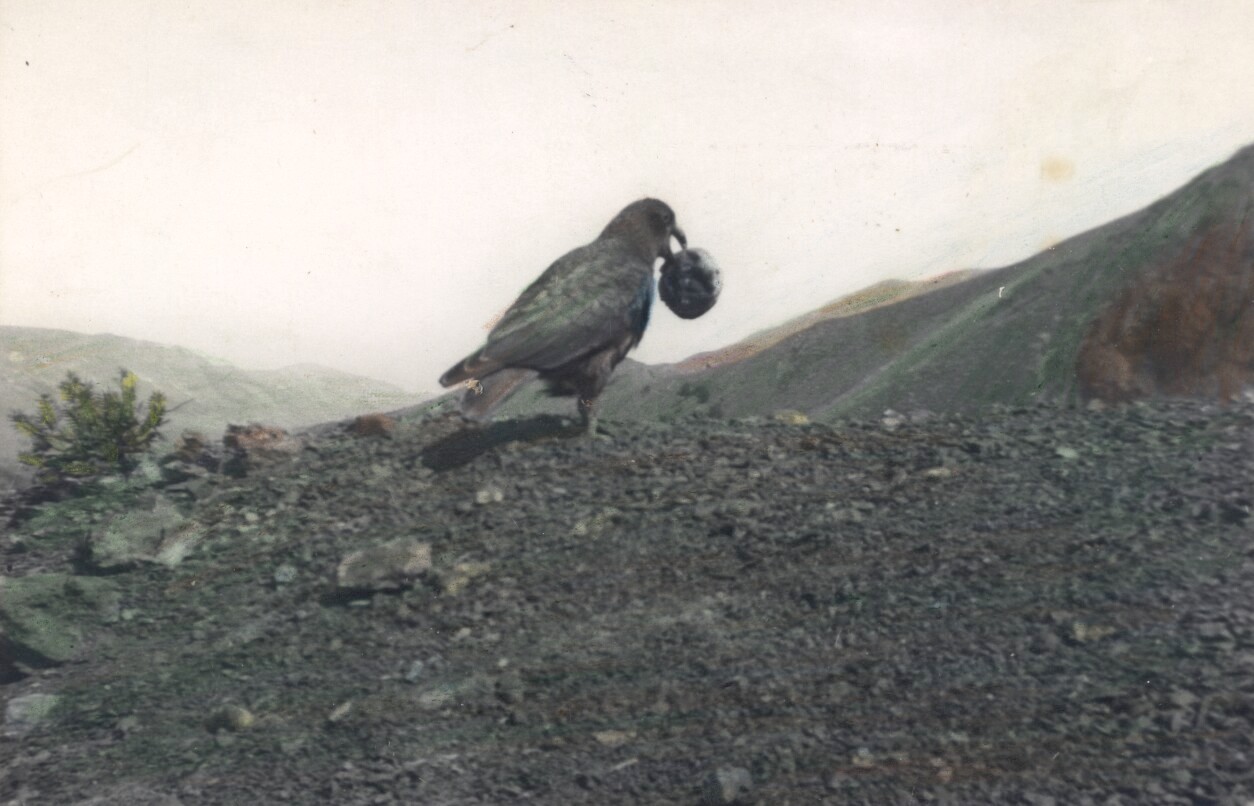



When I was 9 or 10 I very delicately coloured some of the photos above with some pencils, as I was developing an interest in colour photography.
Charlie and his kite
There were two major floods on the Clarence river near the time of this story. From old NIWA records: "July 1948 Upper South Island Flooding ( 1948-07-25 ) A large slip came down in Clarence, temporarily blocking the river. The slip was estimated to be 100 ft high (30.5 m) and 750 ft (229 m) wide. On the 27th of November 1952, the Kaikoura coast and Marlborough were hit by the worst southerly storm for many years. The Clarence River was running bank to bank in its heaviest flood since 1923. The Clarence River at Waiauroa Bridge had a peak discharge of 86,000 cusecs (2435 cumecs). The Clarence River at Waiauroa Bridge had a run off intensity of 1.1 in per hour (2.8 cm/hr)".
During a storm event and the Clarence in flood (not neccessarily the big events outlined above), a power line across the Clarence River came down. This would have affected many properties and on some properties milking was interrupted. This explains the urgency to restore power, in spite of the flooded river.
Charlie flew his kite across the Clarence river and a line was used to haul a new or repaired cable across. Two 11000 volt power cables would typically feed a pole transformer to provide 400 volt 3 phase or 240 volt single phase power to small communities.
It is possible that the power cable was a single wire with an earth return. This makes rural electrification more economical as only one wire and a single set of insulators is needed.
Assuming about half a kilometre of cable was involved I can make some guesses as to how things worked. My 6.5 metre length of 3 core flex requires 250 grams of force to pull it through fine gravel. The 11kV line might have a similar diameter if just a few properties were served by it and the span across the river was long. Half a kilometre of cable would require about at least 20 kilograms of force to drag it. Rocks, fast water flow and rough insulation would increase the required force a bit more. A person in chest-high water would not be able to provide much pulling force, but Hesperus could. Hesperus carried 4 half sacks of river pebbles set almost at water level, with two sacks on each side of Hesperus. This ensured that she had a good footing, in deeper water, as well as a good pulling capability.
I don't know what kind of kite Charlie flew. When flying kites on a farm in the Wairarapa I found that a Box-Kite performed much better than a traditional kite with a tail in very strong winds. Box kites were not common but were well described in many books of the time. A good one, with high lift, would take about an hour to make using bamboo and fabric. Any kite with a sufficiently rigid frame would do.
The operation might have run as follows:
- Charlie flew the kite in a strong southerly wind over the river
- When enough string had been let out, he walked towards the river so the kite dropped down on the northern side of the river.
- Charlie may have attached some stronger baling twine to the thin kite string so that could be pulled across to the northern bank of the river.
- The twine was securely tied to the power cable, which would have unspooled from a reel on the back of a small electrical maintenance truck on the northern bank of the river.
- It is possible that the old cable was repaired and reused.
- The twine with the power cable attached would then have been pulled in by Charlie and any helpers.
- At some point the steadily increasing force required was likely to break the twine.
- Hesperus was led into the river, following the twine until the end of the power cable was found.
- The cable was attached to, or fashioned into, a harness around the shoulders of, Hesperus. Charlie would be leading Hesperus in chest high water.
- One big long pull from Hesperus would have landed the cable on the Southern side.
- This was likely done before lunch and power was probably restored by the electrical crew before evening milking.
This partly fictional account will be updated as more details become known. For example there was a writeup in a local newspaper that I have yet to locate. I have tried to work things out using details in the photos and the simplest explanation. My sister Diane has a faded photo of Hesperus set up for similar work. Because the photo is so faded she made the drawing below from this photo.
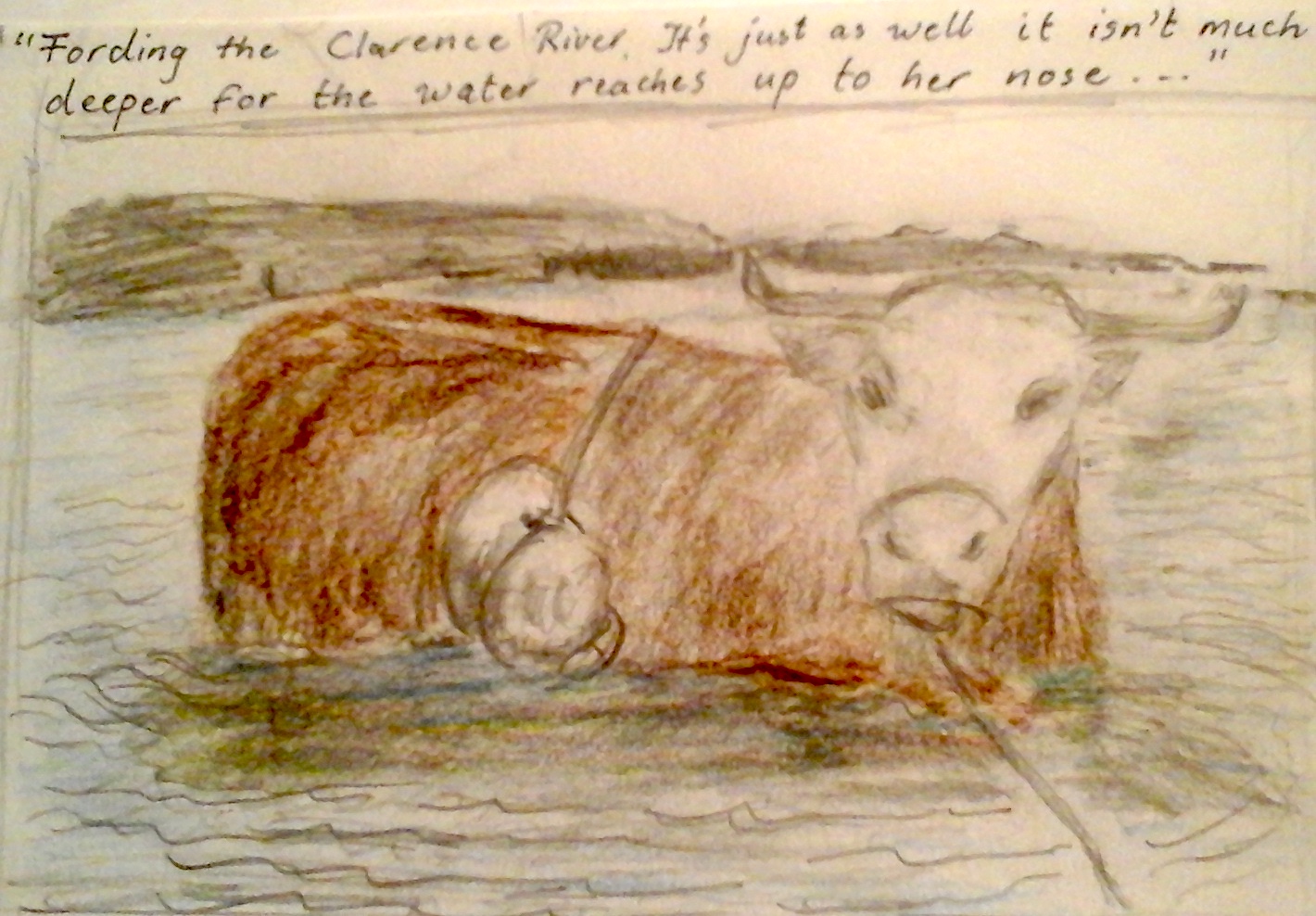
Self Portrait

In this photo Charlie posed a cow, set the folding camera time exposure of 10 seconds, triggered the shutter, walked over to the cow, removed his untied boots which are seen in front, stood on the canvas in his socks, got on her back, stood up, turned, removed his hat, posed, all within 10 seconds, and without disturbing the cow. Maybe the smell of freshly removed boots lulled the cow into a false sense of security.
I don't think this cow is Hesperus as the markings are different and this cow does not have horns. I don't think there was a second person taking the photo, as myself, my father, my uncles Ian and Charlie would all have regarded it as a problem to be solved, in stages, until a successful result was obtained. There is some hay or collected grass in front of the cow. There were a few photographic failures. I have seen a few photos where the operation was not able to be completed in time and Charlie is caught mid-pose. From the shadows the photo was taken near the middle of the day. Note the limestone country in the background, which was disturbed by the recent earthquake. The major earthquake slip area is out of the picture well to the left. The photo above shows the main part of the farm looking south-west and the camera location is several paddocks away from the homestead, closer to the hills. The photo below is taken from near the homestead, also looking south-west. Charlie took some of his annual leave in the hills and valleys beyond.

Farm Work
Like for most of us, there was little time for photography while working. The photo below belongs to Jane Millton and she kindly let me re-photograph it at the kitchen table. On the left is Jane's father, David Middleton and Charlie is up on top of the Hay. Charlie is wearing gloves as handling the dry rectangular hay bales is hard on the hands. In preparation the hay bales were compressed and held with knotted twine, using an automatic hay baler machine. They have just finished loading and are leaving to feed out hay on a hot dry summer day. The caption reads:
" 1948. Model B Allis Chalmers Tractor. New Andrews and Bowen 8, Bales Trailer. David, Charlie Patterson. "
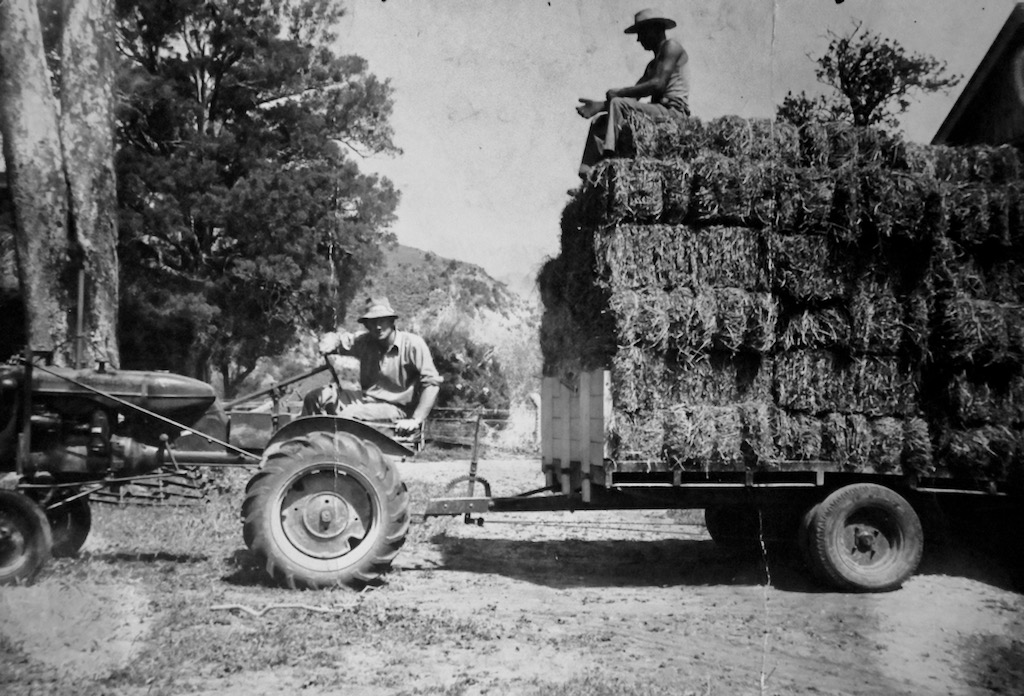
Portable Music
Uncle Charlie also sent me photos where he was playing music to his cattle with his latest portable music playing device. The gramophone required no batteries and was simply wound up before each 10 inch diameter, 78 rpm, record was played. A folded horn built inside the box directed and amplified the sound without any electronics. There was probably room inside the lid to keep several records. Typically the box would have been covered in black leatherette, but here the box was plain wood.
I had searched for these lost photos for a long time, until I found them in a box of my early unmounted prints. Charlie looks younger here. These two photos may be from Balfour in Southland. Again, these are "selfie" photos, using a folding camera with a 10 second self-timer in the shutter. He probably used the gramophone at Clarence.
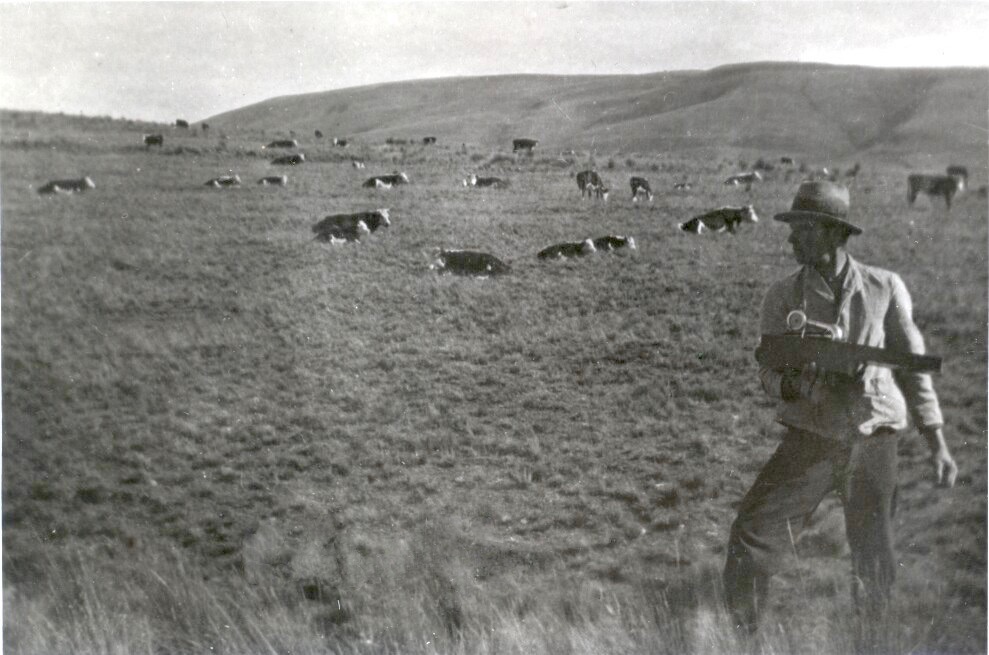

This second photo shows the gramophone more clearly and the nickel-plated tone-arm with a diaphragm and the needle holder is connected to the middle. The tone-arm is hollow and it gradually expands and opens into the folded horn in the box below. This amplifies the sound from the record in the same way that musical instruments can play loudly. The record is set onto a turntable below the tone-arm, and it is being played. The turntable has a felt mat which helps to protect and grip the record. The needle, via its holder, vibrates the centre of the diaphragm which, in turn, vibrates the air in the horn to produce a reasonably loud sound. The crank on the side is for winding up the clockwork motor, which rotates the record at 78 rpm for about 3 minutes. The spring is long for duration and wide to produce a suitable driving force.
Before closing the box the tone-arm was folded down into the lower half of the box, leaving room for the records in the upper half. The crank was removed and packed inside. After closing the lid the gramophone was carried using the handle attached to the case. The gramophone shown here was smaller than average, and may have been rebuilt from old parts, so some of these refinements may not have been present.
Postscript
Jane Millton told me Charlie rode on the main road with a number plate tied to Hesperus's horns. It was probably to indicate to other road users that he was entitled to be there. He delivered or collected mail at Clarence Bridge when the bridge was damaged. Clarence Bridge was on the north side of the river, so fording the river was an alternative route. There was a Road Services or Newmans bus-stop there and small items could be delivered or picked up as part of a basic courier service. The round trip took about an hour to complete. Normally the trip would have been made, in much less time, by a farm vehicle or even a bicycle.


JEPSPECTRO - Home Page
Email: replace at with @
jepattersonatactrix.co.nz
Blogs and Links
Dizzy's Folding Bike BlogTrails and Touring
Hawke's Bay Cycle TrailsOtago Rail Trail
Tasman Great Taste Trail
NZ by Bike
Ultralight Bicycle Touring
Crazyguyonabike Touring
Kennett Brothers
Holland Bicycle Tours